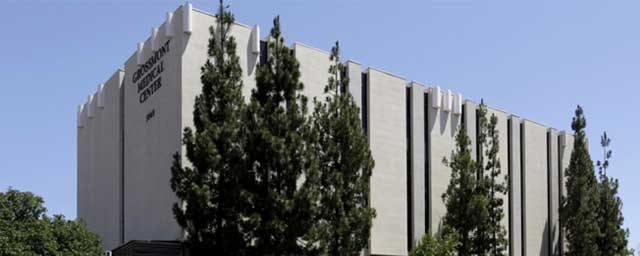Shoulder Arthroscopy
Arthroscopy is a procedure that orthopedic surgeons use to inspect, diagnose, and repair problems inside a joint.
The word arthroscopy comes from two Greek words, “arthro” (joint) and “skopein” (to look). The term literally means “to look within the joint.” During shoulder arthroscopy, Dr. Allsing inserts a small camera, called an arthroscope, into your shoulder joint. The camera displays pictures on a television screen, and he uses these images to guide miniature surgical instruments.
Because the arthroscope and surgical instruments are thin, in many cases, Dr. Allsing can use very small incisions (cuts), rather than the larger incision needed for standard, open surgery. This results in less pain for patients, and shortens the time it takes to recover and return to favorite activities.
In certain circumstances, Dr. Allsing will discuss with you the need to utilize a miniature open incision in addition to the arthroscopic buttonhole incisions. This incision can often improve surgical access for removal of bone and repair of tendons.
Anatomy
Your shoulder is a complex joint that is capable of more motion than any other joint in your body. It is made up of three bones: your upper arm bone (humerus), your shoulder blade (scapula), and your collarbone (clavicle).
Ball and socket. The head of your upper arm bone fits into a rounded socket in your shoulder blade. This socket is called the glenoid. A slippery tissue called articular cartilage covers the surface of the ball and the socket. It creates a smooth, frictionless surface that helps the bones glide easily across each other.
The glenoid is ringed by strong fibrous cartilage called the labrum. The labrum forms a gasket around the socket, adds stability, and cushions the joint.
Shoulder capsule. The joint is surrounded by bands of tissue called ligaments. They form a capsule that holds the joint together. The undersurface of the capsule is lined by a thin membrane called the synovium. It produces synovial fluid that lubricates the shoulder joint.
Rotator cuff. Four tendons surround the shoulder capsule and help keep your arm bone centered in your shoulder socket. This thick tendon material is called the rotator cuff. The cuff covers the head of the humerus and attaches it to your shoulder blade.
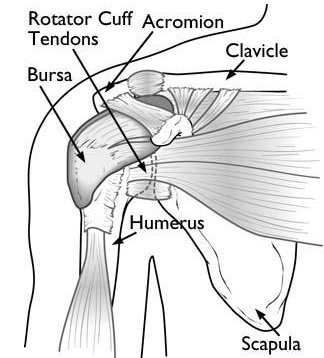
Normal anatomy of the shoulder.
Bursa. There is a lubricating sac called a bursa between the rotator cuff and the bone on top of your shoulder (acromion). The bursa helps the rotator cuff tendons glide smoothly when you move your arm.
When Shoulder Arthroscopy Is Recommended
Your doctor may recommend shoulder arthroscopy if you have a painful condition that does not respond to nonsurgical treatment. Nonsurgical treatment includes rest, physical therapy, and medications or injections that can reduce inflammation. Inflammation is one of your body’s normal reactions to injury or disease. In an injured or diseased shoulder joint, inflammation causes swelling, pain, and stiffness.
Injury, overuse, and age-related wear and tear are responsible for most shoulder problems. Shoulder arthroscopy may relieve painful symptoms of many problems that damage the rotator cuff tendons, labrum, articular cartilage, and other soft tissues surrounding the joint.
Common arthroscopic procedures include:
- Rotator cuff repair
- Bone spur removal
- Removal or repair of the labrum
- Repair of ligaments
- Removal of inflamed tissue or loose cartilage
- Repair for recurrent shoulder dislocation
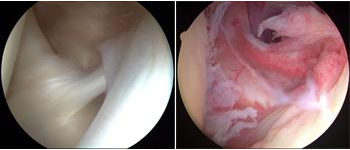
These photos taken through an arthroscope show a normal shoulder joint lining and an inflamed joint lining damaged by frozen shoulder.
Some surgical procedures still require open surgery with more extensive incisions.
Planning for Surgery
Dr. Allsing may ask you to see your primary doctor to make sure that you do not have any medical problems that need to be addressed before your surgery. Blood tests, an electrocardiogram, or chest x-ray may be needed to safely perform your surgery.
If you have certain health risks, a more extensive evaluation may be necessary before your surgery. Be sure to inform your orthopedic surgeon of any medications or supplements that you take. You may need to stop taking some of these prior to surgery.
If you are generally healthy, your arthroscopy will most likely be performed as an outpatient. This means you will not need to stay overnight at the hospital.
During your pre-operative meeting we will provide specific details about your procedure. Make sure to follow the instructions on when to arrive and especially on when to stop eating or drinking prior to your surgery.
Before the operation, a member of the anesthesia staff will talk with you about anesthesia options.
Most arthroscopic procedures take about an hour, however, the length of your surgery will depend on what Dr. Allsing finds and what repairs are required.
Surgical Procedure
Positioning and Preparation
Once in the operating room, you will be positioned so that Dr. Allsing can easily adjust the arthroscope to have a clear view of the inside of your shoulder.
Once you are positioned, the surgical team will spread an antiseptic solution over your shoulder to clean the skin. They will cover your shoulder and arm with sterile drapes
Procedure
Dr. Allsing will first inject fluid into the shoulder to inflate the joint. This makes it easier to see all the structures of your shoulder through the arthroscope. Then he will make a small puncture in your shoulder (about the size of a buttonhole) for the arthroscope. Fluid flows through the arthroscope to keep the view clear and control any bleeding. Images from the arthroscope are projected on the video screen showing your surgeon the inside of your shoulder and any damage.
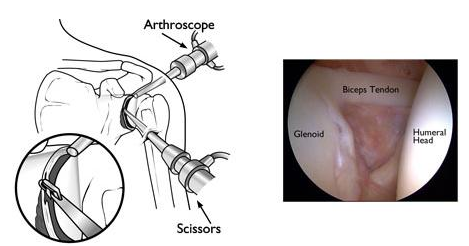
(Left) During arthroscopy, your surgeon inserts the arthroscope and small instruments into your shoulder joint. (Right) An arthroscopic view of the inside of the shoulder joint.
Once the problem is clearly identified, Dr. Allsing will insert other small instruments through separate incisions to repair it. Specialized instruments are used for tasks like shaving, cutting, grasping, suture passing, and knot tying. In many cases, special devices are used to anchor stitches into bone.
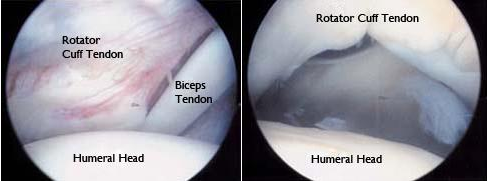
(Left) An arthroscopic view of a healthy shoulder joint. (Right) In this image of a rotator cuff tear, a large gap can be seen between the edge of the rotator cuff tendon and the humeral head.
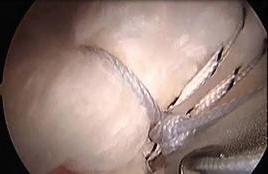
The tendon has been re-attached to the humeral head with sutures.
Your incisions will be closed with stitches and skin glue and a waterproof bandage
Recovery
Postoperative
After surgery, you will stay in the recovery room for 1 to 2 hours before being discharged home. Nurses will monitor your responsiveness and provide pain medication, if needed. You will need someone to drive you home and stay with you for at least the first night.
At Home
It will take time for your shoulder joint to completely recover.
You should expect some pain and discomfort after surgery. Ice will help relieve pain and swelling. We will prescribe pain medicine.
Although it does not affect how your shoulder heals, lying flat may pull on your shoulder and cause discomfort. Some patients are more comfortable sleeping in a reclining chair or propped up in bed during the first days after surgery.
Five days after surgery you can remove the waterproof dressing. You may shower once your wounds are no longer draining, but try not to soak or scrub your incisions.
Rehabilitation
Rehabilitation plays an important role in getting you back to your daily activities. An exercise program will help you regain shoulder strength and motion. We will recommend a physical therapy provider that will assist you with this.
It is important that you make a strong effort at rehabilitation in order for your surgery to succeed.
Long-Term Outcomes
Because patients have varied health conditions, complete recovery time is different for everyone.
Full recovery may take several months. Although it can be a slow process, following our guidelines and rehabilitation plan is vital to a successful outcome.



